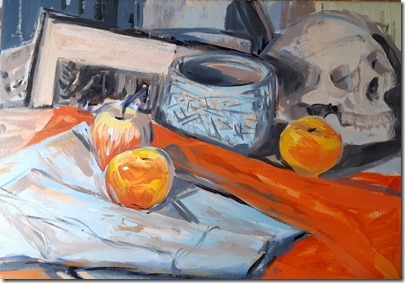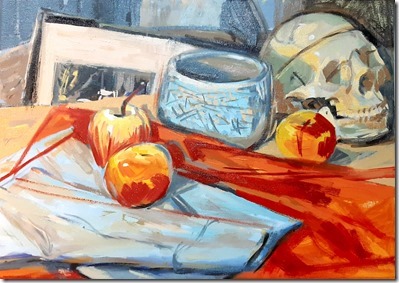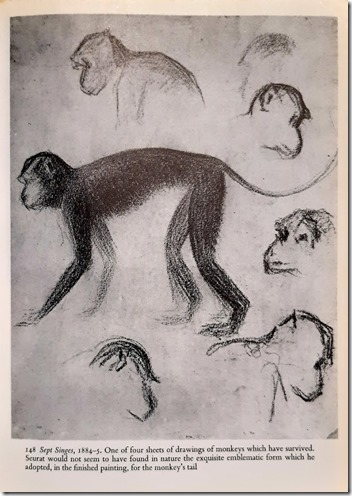Tuesday Art – Spring Term 2024



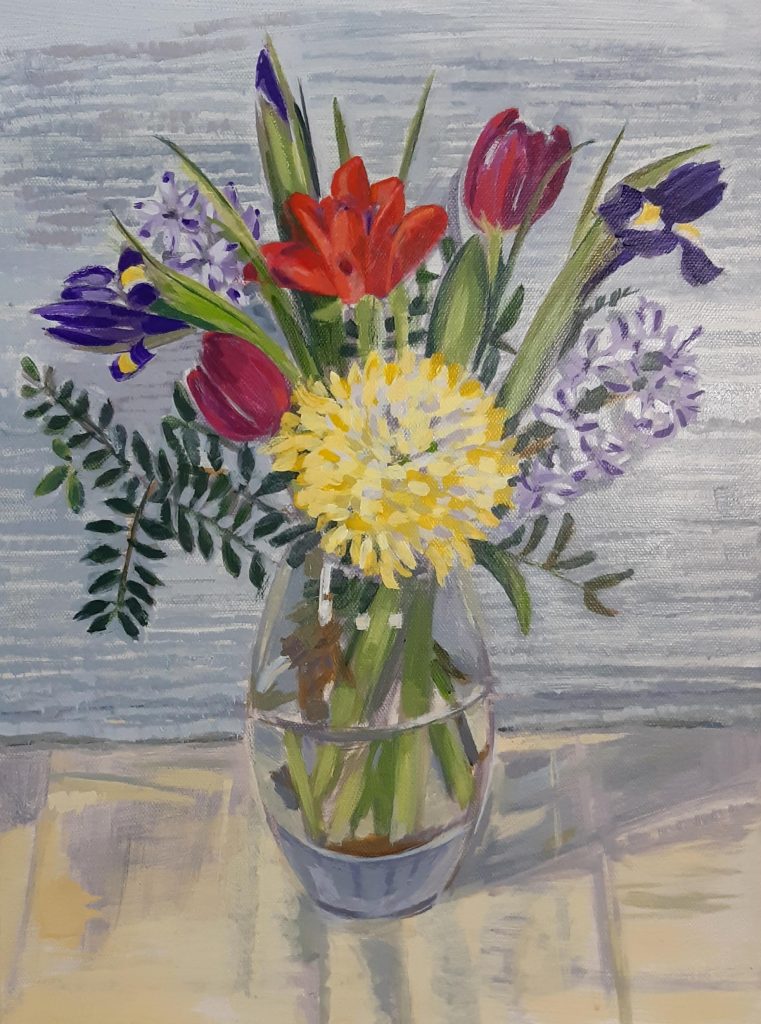

The photos here of my second “Flowers” painting show the process of painting, from start to finish. I followed this rough procedure, 1-5. See if you can spot the differences, from one image to the next. Thanks for tuning in.
- Sketch in monochrome,
- Adding “local” colour with two tones in each flower,
- Futher work, intensifyling the greens, plus more texture in the background,
- Clarifying shapes, building up colour,
- Final details and checking colour, eg, the full contrast in the “pom-pom” flower and the browns in the water changed to grey.
A notable project from towards the end of the Spring Term was “Painting Flowers in Acrylics”.
If you look on my Instagram feed you will see that a few weeks before Easter, we got into painting flowers initially by sketching very loosely from life. I love painting flowers around this time of year – it’s Spring and flowers symbolise this – it helps us to think about the better weather that is coming and getting out of the dark and cold of the winter months. Secondly, it’s also Mother’s Day around this time and flowers are always associated with this celebration. My mother especially loved flowers – she was in charge of the flowers in her local church – so painting flowers reminds me so much of her. She passed away around this time of year in 2016, so it’s an extra special reminder of her and her life. As well as showing paintings of flowers in the Sir James Hawkey Hall show in Woodford in March (see my Art Life page), we painted flowers in class and I spent some extra time at home finishing my demos. Here they are, a pair of flower painting in acrylics. Next, I will be showing you the sequence of staged photos for one of these. Stay tuned!


Top: Flowers with Daffodils, in acrylic on canvas; Above: Flowers with Iris’s, in acrylic on canvas, both by AB.
Art with Anna. Autumn Term 2023.
New Year Display.
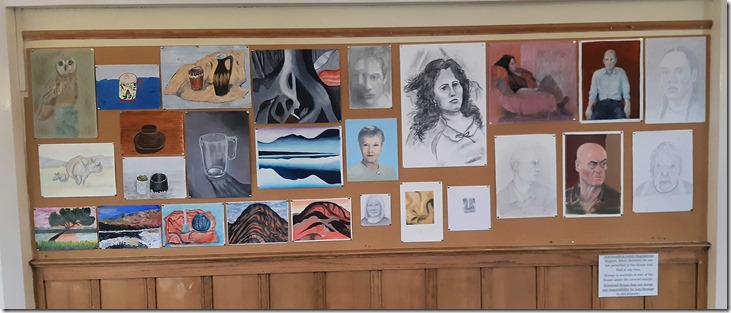
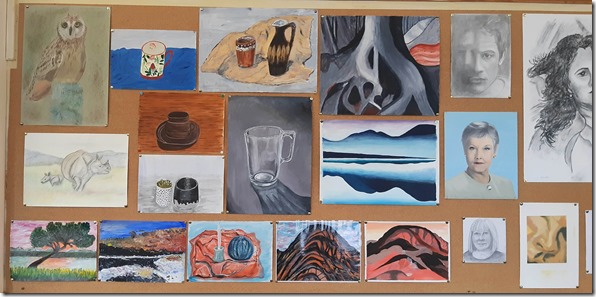
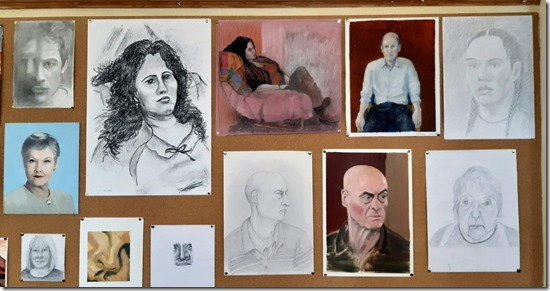
Here is a selection of images from this term in the Portrait Class as well as the Tuesday Art Class.
As you can see, from the post below also, we started with drawing animals, then moved on the landscape in Epping Forest and then looked at the work of Georgia O’Keefe. Some produced their own paintings in her style, which was really impressive. We finished off with drawing cups and mugs from life, ie. observed on the table-top, which was good after some time working from photos.
In the Portrait class, we had a series of interesting models – Michael, the yoga teacher, and Effy the actor. We tried a variety of poses, from formal on a class-room chair, to more casual on an arm-chair. This was interesting. We need to experiment with backgrounds next. Fun homework projects included self-portraits and drawings of details of the face.
Hope you find this interesting. The work will be up in the lobby at Wanstead House until the end of January.
Happy New Year, from Anna.
Here are some examples of your work this term:
Steve and Bridget with their animal drawings, followed by Bridget and Bal, Chris and Charan with their Fallen Trees and finally Francy and Sally with their work inspired by Georgia O’Keeffe.
I hope you enjoy these pieces – hopefully we will have a chance to show them and more in a display at Wanstead House in the New Year. Thanks all for your participation and hard work this term!
Best wishes, Anna. Nov 2023.
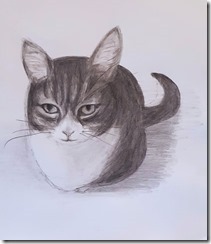
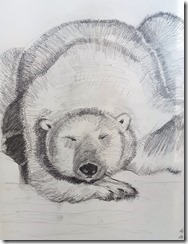
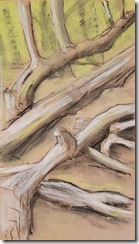
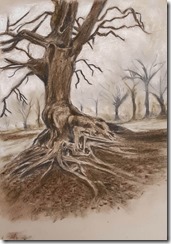
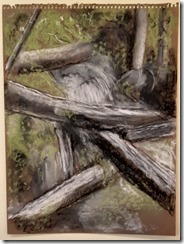
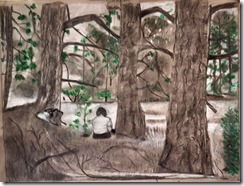


Ground Rules in the Classroom. October 2023.
Anna Bisset is a qualified art tutor and has worked at Redbridge Institute of Adult Education for over 20 years where she receives training in Health and Safety, Risk Assessment, Equality and Diversity, and Safeguarding. Anna is insured to run art groups and workshops. She operates a policy of Equal Opportunity in the classroom and as such, she sets out her ground rules below:
Membership of Wanstead House, must be paid to the office to attend class and use the facilities such as the coffee lounge and the carpark.
Carparking is limited so those with cars need to arrive in good time to get a parking space. Drivers must park up to the fence to maximise the use of the carpark, leaving their membership card in the window so that other members can find you if your car needs to be moved during class. Cars must be removed promptly from the carpark after the end of the class and should not be left in the carpark if the owner is not on site.
Students will receive informal feedback on their work each week. Sometimes, we have group discussions where students can share their work. Occasionally, we have a display of students’ work in the coffee lounge downstairs. If you feel you need more assistance with your work, please ask.
New students will find that the classroom is a friendly and supportive place to learn. Students are expected to conduct themselves in a way that suits the classroom setting. If on any occasion Anna is concerned about an individual’s behaviour, she will speak to the student at the end of the class with a view to resolving the situation. If agreement cannot be reached, the student may have to leave the class. Such behaviour includes but is not limited to:
Phones and Ipads are often used for work, but please keep your phone on silent for the duration of the class. If you need to leave your phone on, eg if you are waiting for an important phone-call such as a hospital appointment, please use the vibrate setting and leave the room before taking the call.
Breaktime is the ideal time for catching up with other class members over a coffee downstairs. If noise levels in the classroom interfere with the working atmosphere, Anna will ask the member/members in class to adjust accordingly.
Class starts promptly at 10am and finishes at 12.15pm. We try to keep a reasonable amount of time undisturbed for painting and drawing, apart from break, so if you have a reason for arriving late and/or leaving early, please let Anna know before the class, as late arrivals and early leavers disturb the class.
Please let Anna know before the class if are you are going to be away the next week or for holidays etc. for the purposes of course planning. You can leave a message by email at: asbisset@gmail.com
Resources for projects: Sometimes students are asked to bring in objects for still life or images they have collected. This is helpful as it would not be possible for the tutor to provide for everyone all the time. Sometimes, Anna will bring in the resources. If you have borrowed images to work on, please return them when you have finished your work. You can always get a colour copy of the image from the office or elsewhere if you would like it for reference. Black and white copies and hand-outs can be kept by students.
WhatsApp Groups. If the class has a WhatsApp group, there is a set of guidelines for the class to use when they are online – please ask if required.
Thank you. Your co-operation helps the class to run smoothly.
October 2023.
Exhibitions in and around London
We tend to focus on the central London galleries for exhibitions, but there are more and more local exhibitions and galleries which are more accessible. In addition to this, there are many TV programs and online resources. Portrait Artist of the Year has just started on Sky Arts.
 Online, look at Saied Dai’s portrait of Teresa May here: https://www.saieddai.co.uk/
Online, look at Saied Dai’s portrait of Teresa May here: https://www.saieddai.co.uk/
And watch an interview with the artist, here: https://www.saieddai.co.uk/still-life/
National Gallery:
Frans Hals: Until 21 January 2024 Tickets from £20.
“Four hundred years since they were painted, Frans Hals’s portraits still breathe with life. There’s the hint of a smile, a hand resting nonchalantly on a hip, and just occasionally, a burst of  laughter. Hals was one of the most sought-after painters of his generation. A gifted artist whose deft brushwork was unparalleled, he built his reputation on a new style of portrait – highly unusual in his time – that showed relaxed, lively sitters, often smiling, and even laughing. 17th-century Dutch audiences were enthralled, and the popularity of his portraits earned him the status of Haarlem’s famous son”. The Laughing Cavalier by Frans Hals. 1624. Wallace Collection.
laughter. Hals was one of the most sought-after painters of his generation. A gifted artist whose deft brushwork was unparalleled, he built his reputation on a new style of portrait – highly unusual in his time – that showed relaxed, lively sitters, often smiling, and even laughing. 17th-century Dutch audiences were enthralled, and the popularity of his portraits earned him the status of Haarlem’s famous son”. The Laughing Cavalier by Frans Hals. 1624. Wallace Collection.
National Portrait Gallery:
The NPG had a revamp earlier in the year and has been so busy since that I haven’t got around to visiting it yet. But I’m sure it’s well worth a visit – you just have to pick the right time – a weekday would be best.
 The Courtauld Gallery: Claudette Johnson
The Courtauld Gallery: Claudette Johnson
29 Sept 2023 – 14 Jan 2024
Denise Coates Exhibition Galleries. A major exhibition of work by British artist Claudette Johnson (born 1959) is now open at The Courtauld Gallery.
A founding member of the Black British Arts Movement, Claudette Johnson is considered one of the most significant figurative artists of her generation. For over 30 years she has created large-scale drawings of Black women and men that are at once intimate and powerful.
The Wallace Collection: Notes: One of the nice things about going to lesser-known galleries is that you can often see works that pop up in other exhibitions, as they lend their works to other galleries for this purpose. Eg. The Laughing Cavalier” by Frans Hals, usually in the Wallace collection, is currently on show in the Frans Hals exhibition at the National Gallery. Also, we get to know significant works by artists who are becoming better-known. At the recent exhibition “Portraits of Dogs” at the Wallace Collection, I saw a  painting of a dog called “Brizo” by female French artist, Rosa Bonheur, who is currently becoming better-known due to the growing interest in female artists of the past. This painting is also owned by the Wallace Collection.
painting of a dog called “Brizo” by female French artist, Rosa Bonheur, who is currently becoming better-known due to the growing interest in female artists of the past. This painting is also owned by the Wallace Collection.
Seen here: “Dog Lying on a ledge”, unknown artist, also in the exhibition.
Private galleries: Private art galleries often show their work at big exhibitions or trade fairs such as Parallax Art Fair, Kensington Town Hall (28-29th October). Going to art fairs can be a good way to see what sort of work is selling in galleries at the moment, showing contemporary artists as well as artists from the past. Paintings by artists who are relatively unknown will be rubbing shoulders with big names like Henry Moore – you can easily see a Lowry or a Bridget Riley, for example, and it can be quite revealing to see the art world at work in front of your eyes. Other fairs include London Art Fair in Islington and The Affordable Art Fair in Battersea.
Local Exhibitions and Galleries:
The Stone Space, Leytonstone
“Strange Occurrences” by Steve Marriott
26.10.23-19.11.23 Private View 26.10.23
The Art Pavilion. “Glasgow Girls”
Mile End Park, Resist much, obey little
Clinton Rd Rosemary Beaton I Lesley Burr I Alison Harper
London E3 4QY
Exhibition Dates: 18th – 27th November 2023
11- 6pm
Private view Friday 17th November 6 – 9pm
William Morris Gallery
Epping Forest District Museum, Waltham Abbey.
Out of Town
The Holburne Museum, Bath.
Gwen John – “Art and Life in London and Paris” – from Pallant House, Chichester. “One of my shows of the year. John emerges as a soulful, inventive, brilliant presence.” Waldemar Januszczak, The Times
Enjoy! October 2023. Anna B.
Hello Class – here are the dates for classes this year at Wanstead House:
Class starts: 19th September.
Half Term: 24th October.
Last Class: 12th December.
Spring Term: 2024
Class starts: 9th January.
Half Term: 20th February.
Last Class: 26th March.
Summer Term: 2024
Class starts: 16th April.
Half Term: 28th May.
Last Class: 2nd July.
Drawings of monkeys by Seurat, 1884-5
September 2023
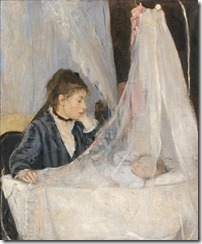
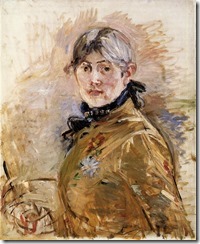
1. “The Cradle” 1872 and 2. “Self-portrait” 1885 by Berte Morisot.
Hi everyone,
hope you have had a lovely summer break – I certainly have, in spite of the weather! One of my highlights was to go see the Berte Morisot exhibition at Dulwich Picture Gallery. It was very interesting to hear about how she developed her work in spite of the restrictions on women who wanted to be artists. As a result, she had to focus on portraiture and the domestic interior. However, she took part in all but one of the Impressionists Exhibitions and as such led the way in Modernist methods of painting and subject matter. As you can see here in the Self-portrait, her style of painting could be extremely loose and free. In “The Cradle”, the composition subtley implies something of the frustration women felt in their roles in the home. The exhibition is still on until the 10th September.
Also to let you know, I will be taking part in Wanstead Festival on September 17th this year, with demos and a chance for you to have a go at drawing portraits on the Redbridge Institute stall (12-2pm) and the human figure on the Art Group Wanstead Stall (2-4pm), so it would be nice to see you there, if you can make it.
If you feel like practising your figure-work a bit more this term, you might like to attend the short courses I am doing at Redbridge Institute – figure-drawing for 2 Saturdays in October – 14th and 21st, 12.30 – 3pm. You can enrol on this course by going to the Redbridge Institute of Creative Arts website, here:
I hope you enjoy the approaching Autumn season – look out for natural forms and seasonal produce which always makes a good subject matter for getting back into art.
Best wishes and see you soon,
Anna.
June 2023: Homage to Cezanne 3: “Bananas in the Landscape”
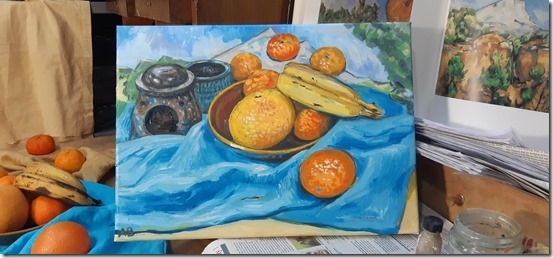 I enjoyed painting this series and looking for more ways to reference an artist like Cezanne in the work.
I enjoyed painting this series and looking for more ways to reference an artist like Cezanne in the work.
After “Chicken Egg-cup” and “Cezanne Book”, this one, “Bananas in the Landscape” sets the still life directly into a landscape and questions what is real – still life or mountain – or neither!
Anyway, I like the composition, and perhaps that is the thing I really take from Cezanne – the diagonals that lead you around the picture, giving a sense of movement. There is a strong pull to the left by the incense-burner which emphasizes the diagonals, but the asymmetry is underpinned by the symmetry of the mountain, the cloth meeting the table in the foreground and the grapefruit in the bowl. I enjoy the strong colour too in Cezanne’s work, as well as the use of outline!
Anna.
May 2023: Collage in Class!
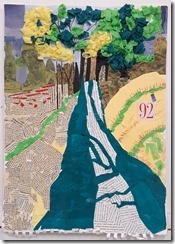
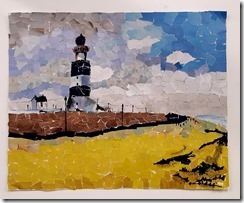
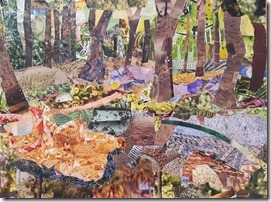
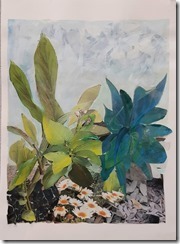
Students really enjoyed this project as it was completely different to their normal medium – acrylic paint. We started with a typical subject – Bluebells or other landscape images – and, working from photos, students worked directly in collage, perhaps sketching out the image, or their chosen part of an image, to start with. The collage was built up gradually over a period of 3 or 4 weeks, taking coloured paper from magazines or from collected coloured papers, tissue etc. We referred to many artists who use collage – Kurt Schwitters, Hannah Hoch, , as well as Matisse, Picasso and Robert Rauschenberg. Mary Georgina Filmer was a little-known Victorian artist who used the scrap-book style of photomontage as her medium – we found her work surprising and fun! Artists of the past have used collage as a method of protest or to shock. Now collage is an accepted medium of it’s own.
Some remained faithful to the original as much as they could, using the torn or cut paper literally as their palette of colour.
Others really enjoyed how bits of photographs appeared in to the picture, from the imagery selected from magazines, adding a surreal element to the work – more photomontage then collage.
Some added paint to the final collage, to reach their desired result. Others played with the graphic or text elements found in magazines as well as the formal elements of colour, shape and tone, which added a “Pop” aspect to the work, or referred back to Kurt Schwitters, one of the first of the Modern movement to use collage.
It was amazing how everyone took a slightly different take on the project, finding their own way to a conclusion. You can see some work-in-progress images below too. Well done everyone!

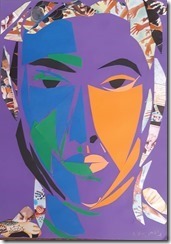
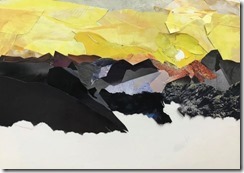
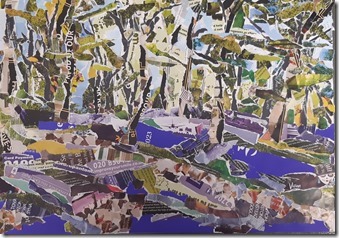

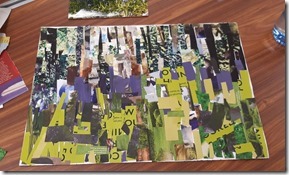
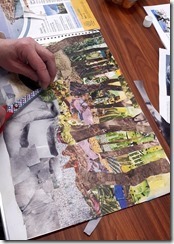

May 2023: Homage to Cezanne 2: “Chicken Egg-cup”.
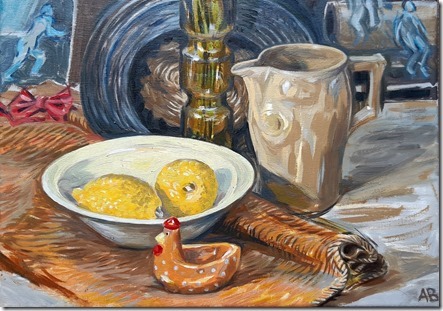
This is the final stage in the painting, Still Life: “Chicken Egg-cup” – aka “Bathers”. Below, you can see earlier stages: 1. Sketching out with warm and cool colours; 2. Adding “local” colour; 3. Further tone and contrast in all areas; 4. Realigning the hat and checking all ellipses; 5. Adding the bow-tie, spots on the egg-cup and bathers in the back-ground.
In the final image, here, I spent time getting the glass vase in the middle to look glassy with a warm green glaze; I worked on the folds of the cloth in the foreground; and shadows on the table-top.
I enjoyed all the different textures – how to hint at these without spending too long – but allowing certain elements to become as sharp as I felt they needed – Decisions!
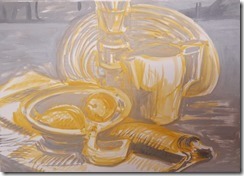


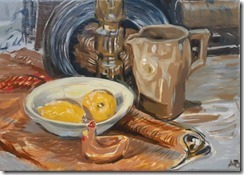
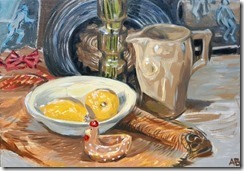
April 2023: Homage to Cezanne 1: “Cezanne Book”.
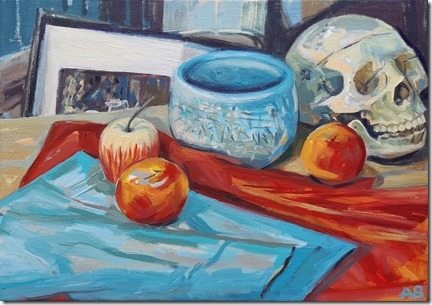
In February this year, I went to see the Cezanne exhibition at Tate Modern. Following this, in all three art classes, Tuesday Art, Bedford House and Art with Anna, we were working on our own still life paintings, having looked at Cezanne’s work and discussed it in class. We also contrasted his work with that of Giorgio Morandi, whose work is currently on show at the Estorick Collection in Islington.
Here is a series of images showing the progress of my painting, “Cezanne Book”, aka “Skull”, which was started in class (Tuesday Art) and finished at home in the studio. They show the various stages that the painting went through on it’s way towards the finish. Sometimes the interim stages have qualities that are lost in the finished painting, which is why it is good to photograph the work whilst it is being made. As always, it is about when to stop and what is it that you are trying to achieve….?
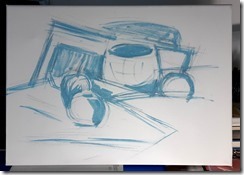

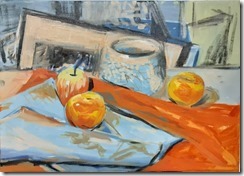
1. Sketching out. 2. Blocking in. 3. Adding tone and shading.
